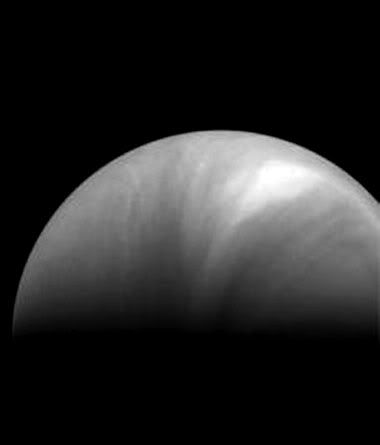 Evidently, Venus has once again managed to flummox experts across the planet with its latest stunt -- the appearance of a bright spot amongst the clouds in its southern hemisphere. An awful lot of people are talking about it, but no one really seems to know what's going on over there!
Evidently, Venus has once again managed to flummox experts across the planet with its latest stunt -- the appearance of a bright spot amongst the clouds in its southern hemisphere. An awful lot of people are talking about it, but no one really seems to know what's going on over there!First discovered by an amateur astronomer named Frank Melillo, from Holtsville NY* on July 19th and later confirmed by ESA's Venus Express probe, the cause of the spot is unclear. Which is to say that the experts are clueless. ESA estimate that the spot probably formed about 4 days before it was first spotted from Earth. Since then, being dragged by the venusian winds, it's elongated drastically. It probably won't last long before whatever it is diffuses into the atmosphere, causing it to fade. But the biggest question remains that no one knows why it exists to begin with.
We do know one thing about Venus's clouds. The most reflective patches are droplets of pure sulfuric acid (which start to crystallise at higher altitudes). Assuming there isn't any drastically different atmospheric chemistry going on here, it would be a safe bet that this spot may be a concentration of sulfuric acid. The spot seems to be quite high up in the atmosphere. Around 65-70km high, which is a region where solar ultraviolet can drive a lot of chemistry. If there was a sudden upsurge of sulfur dioxide (SO2) into this part of the atmosphere, it could happily react with the water vapour found up there and make a bright patch of sulfuric acid.
I hasten to add, that this is speculation on my part, and not being a planetary scientist I could easily be wrong. Though if this was indeed what happened, a sudden upwelling could conceivably be caused by a volcano. I've written before about how no direct evidence has been found for present day volcanoes on Venus. Could we be looking at the first sign of volcanism? It would certainly be quite exciting -- settling the matter of how Venus's acidic clouds are replenished, and helping explain a lot of the planet's chemistry!
Unfortunately, there are quite a few things wrong with that idea. Firstly, for an eruption to propel gasses that high into the atmosphere, it would have to be incredibly powerful. Probably comparable to Krakatoa's eruption back in 1883. On the other hand, Venus's atmosphere is much much denser than Earth's, and venusian volcanoes aren't thought to work that way. They're expected to be more akin to basaltic shield volcanoes like Mauna Loa in Hawaii. Basaltic volcanoes produce thin runny lava. They don't cause big explosions. Another problem with the idea is that the spot doesn't lie near any suspected volcanoes, although it's likely to have drifted significantly far from where it originated thanks to those strong venusian winds.

Melillo's original images, showing the first sighting of the bright spot.
Other ideas suggested have included charges particles from the solar wind interacting with Venus's atmosphere, or even random atmospheric currents conentrating material through sheer chance. There's also a possibility there are atmospheric convection currents that we don't yet know about. Perhaps this was some kind of Venusian hurricane, working in a similar way to Jupiter's Great Red Spot.
We've seen bright patches in the atmosphere of Venus before. Periodically, great swathes of those clouds will appear to brighten. Notably in 2007, there were bright patches in both the north and south hemispheres of the planet. Similarly, in early 2008, the entire southern hemisphere of Venus appeared to brighten briefly before fading back to normal.
This spot appears to be different though, with the spot being so focussed, compared to the previous events. It could be something new. We really don't understand Venus at all. Sometimes it even seems as if the more we learn the less we understand.
*I love how, in astronomy, amateurs can make discoveries and observations every bit as important as the professionals do. It's a wonderful science, even if for that reason alone!
Image credits: ESA/MPS & Frank Melillo (respectively)
No comments:
Post a Comment